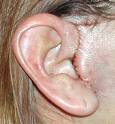The facelift incision and scar in front of the ear is usually placed in a retrotragal (in and out of the ear going behind the bump of cartilage in front of the ear canal) location. (in women, not in men) As the scar runs in this fashion in front of the ear, it becomes virtually undetectable after healing. While patients are understandably concerned about a scar that they can potentially see, they are less aware of what the results can be from behind it.
While I have yet to have a patient complain about how their facelift scar looks behind their ear, I certainly have seen some that I was disappointed in. Whether it was an occipital hairline disruption, a scar band in the ear crease, or a scar that was visible from behind due to a short hairstyle, there is always room for improvement.
Unlike the scar in front of the ear which lies in natural skin creases, the facelift scar behind it does not. Due to the direction of pull of the skin from the neck, the scar behind the ear must usually tail away from the crease of the ear back into the scalp. This is necessary to work out the excess skin and prevent any bunching or dog ear deformity. The pull of skin up and out of the neck must occur in the area behind the ear. Many variations exist on how this scar is placed behind the back of the ear into the hair-bearing scalp. One of the improvements is to make this cutback as far up the back of the ear as possible. Another option is to carry it straight up vertically into the scalp above the ear. This requires more dissection and time but does eliminate it completely from the postauricular area.
Today’s short or limited facelifts use only a very limited incision behind the ear. This is not done so much to eliminate postauricular scarring as it is to lessen the extent of the facelift procedure. Most of the neck skin is worked out upward by the direction of the pull in front of the ear. This does eliminate the need for dissection behind the ear but also decreases the amount of neck improvement that is possible. Even so, a small skin fold under or behind the earlobe will almost always occur. Some choose to leave it as a fold behind the ear. I prefer in my Indianapolis plastic surgery practice to work it out to about the middle of the ear concha. At that point, a small posterior extension is done to get rid of it. As long as the tail of this horizontal limb stays in the shadow of the helix of the ear, this is not an aesthetic problem.
Barry L. Eppley, M.D., D.M.D.
Indianapolis, Indiana



